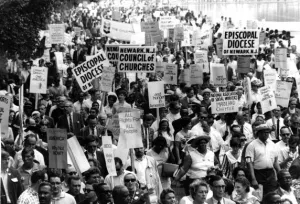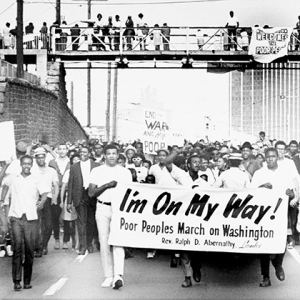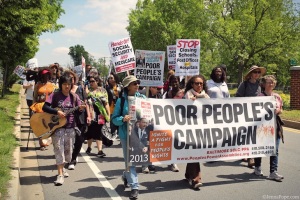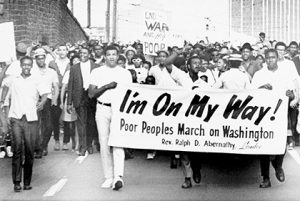At the time of his murder, Dr. King was working on The Poor People’s Campaign – a mass movement with its Poor People’s March on Washington planned for summer 1968. It was a more radical successor to the March on Washington on August 1963 and called for an occupation – Resurrection City – a tented community of thousands that would stay until they got their demands implemented.

This idea was close to his heart. It was a reaction to his great disappointment and frustration where – in real terms – very little had been delivered for African Americans. ‘ White America never did intend to integrate housing, integrate schools or be fair with the Negro about jobs’… ’Freedom is never voluntarily granted by the oppressor. It must be demanded by the oppressed’.
Meantime, the war in Vietnam was taking lives, resources and capturing media attention. In1967 he declared that the Vietnam War was being waged on behalf of the ‘wealthy and the secure while we create hell for the poor’. And that ‘the greatest purveyor of violence in the world today- my own government.’
He was latterly developing political strategies that forged links between race and class, within the framework of a profound challenge to the wider economic system. He said ‘we must rapidly begin the shift form a thing oriented society to a people oriented society’. And he argued that ‘something is wrong with capitalism’.
‘For years I labored with the idea of reforming the existing institutions of society through a little change here and little change there…but now I feel quite differently. You have got to have a reconstruction of the whole society, a revolution of values… We are not interested in being integrated into this value structure. Power must be relocated, a radical redistribution of power must take place.’
So, in the summer of 1967, King announced what was to be the most expansively radical adventure of his life – a national movement called the Poor People’s Campaign, mobilizing black, white, hispanic, native American. It was to demand an annual $30bn federal investment to deliver full employment, guaranteed annual income, 300,000 units of low cost housing per year.
On sharing the idea with some of his church supporters, one said: ‘He had done all these other social things but this was the culmination…it was embarking on the financial structure of the country…it was then we understood that Martin Luther King was a revolutionary’. It was planned that the Campaign would start early in 1968. It was ambitious and many felt it was over-ambitious, almost impossible to deliver and therefore doomed to fail.

Dr. King was assassinated on 4th April 1968 and the April 16 edition of USA Look magazine carried a posthumous article from King titled “Showdown for Nonviolence” — his last statement on the Poor People’s Campaign. The article warns of imminent social collapse and suggests that the Campaign presents government with what may be its last opportunity to achieve peaceful change—through an Economic Bill of Rights. Just three weeks after Dr King’s death, the Committee of 100 – set up to lobby on behalf of the campaign- called for just this. On 12th May 1968 Ralph Abernathy, King’s chosen successor to head the Southern Christian Leadership Conference, went forward with the Poor People’s Campaign. Coretta Scott King brought 5,000 demonstrators to Washington, DC, seeking an Economic Bill of Rights. “Resurrection City,” a shantytown, was constructed on the Mall to house many of the visitors who met with congressman and senators to plead their case. 20,000 army soldiers were activated and prepared for a military occupation of the capital should the Poor People’s Campaign pose a threat.
All quotes from Martin Luther King, A Life, by Marshall Frady.
Here is the speech SCLC Reverend Ralph Abernathy speech on the poor people’s campaign at Solidarity Day, June 19, 1968. https://archive.org/details/ReverendRalphAbernathySpeechOnThePoorPeoplesCampaign
The Ongoing Legacy
The memory of the Poor People’s Campaign never died. In the USA it has been marked in many ways ever since.

In 2012 Cornell West and Tavis Smiley launched Ending Poverty: America’s Silent Spaces to educate and enlighten Americans about the impoverished conditions of our brothers and sisters; to empower fellow citizens to fight back against the stigmatization, marginalization and demonization of America’s growing poor population; and narrow the economic gap and launched with the 50th anniversary of the Poor People’s Campaign in mind.
Most recently there was a walk from Baltimore to DC (2013) and an Occupy Sacramento movement event (2014). In November 2014 the SCLC re-launched the idea in Berlin to address extreme poverty through voter registration, feed in, teach in.
And in 2014, The Kairos Center started its own PPC to mobilise USA grassroots groups around the urgent call to end poverty where-ever it exists.
More information: https://kairoscenter.org/ppc/


5 thoughts on “1968 Poor Peoples Campaign”
Comments are closed.